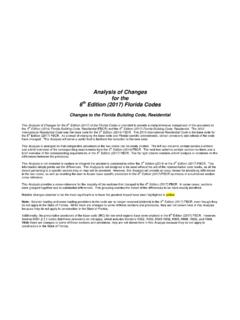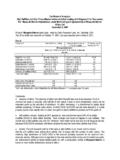Transcription of Defense Acquisition Reform: Background, Analysis, and ...
1 Defense Acquisition reform : background , analysis , and Issues for Congress Moshe Schwartz Specialist in Defense Acquisition May 23, 2014 Congressional Research Service 7-5700 R43566 Defense Acquisition reform : background , analysis , and Issues for Congress Congressional Research Service Summary The Department of Defense (DOD) relies extensively on contractors to equip and support the military in peacetime and during military operations, obligating more than $300 billion on contracts in FY2013. Congress and the executive branch have long been frustrated with waste, mismanagement, and fraud in Defense acquisitions and have spent significant resources attempting to reform and improve the process.
2 These frustrations have led to numerous efforts to improve Defense acquisitions. Since the end of World War II, every Administration and virtually every Secretary of Defense has embarked on an Acquisition reform effort. Yet despite these efforts, cost overruns, schedule delays, and performance shortfalls in Acquisition programs persist. A number of analysts have argued that the successive waves of Acquisition reform have yielded only limited results due in large part to poor workforce management. Most reports have concluded that the key to good acquisitions is having a sufficiently sized and talented Acquisition workforce and giving them the resources, incentives, and authority to do their job.
3 Yet most of the reform efforts of the past decades have not sought to fundamentally and systematically address these workforce-related issues. Significant changes to the national security and industrial landscape in recent years, including consolidation of the Defense industrial base and the increasing complexity of weapon systems, have led many analysts to call for a renewed effort to improve the Acquisition process. Historically, eras of budgetary restraint have been associated with the pursuit and implementation of Acquisition reform . Against the current backdrop of the Budget Control Act of 2011 and declines in Defense spending, the stage may be set for a renewed effort to significantly improve Defense acquisitions.
4 Other factors contributing to a sense among analysts that the time may be ripe for reform include recent experiences in Iraq and Afghanistan and the increasing availability of data to drive decisions. In recent years, DOD has taken a number of steps to improve the process by which it buys goods and services, including rewriting the regulatory structure that governs Defense acquisitions; launching the Better Buying Power and Better Buying Power II initiatives aimed at improving the productivity of the Acquisition system and the industrial base; improving the use of data to support decision making; and establishing a team to develop a legislative proposal aimed at simplifying the laws and regulations governing Defense acquisitions.
5 Many analysts believe that what DOD can do on its own to improve acquisitions can only go so far that significant, effective, and lasting Acquisition reform will occur only with the active participation of Congress. Congress has been critical to advancing Acquisition reform ; such efforts as establishing the Federal Acquisition Regulation, creating Defense Acquisition University, streamlining Acquisition regulations, and enacting the Goldwater-Nichols Act were the result of congressional action. Defense Acquisition reform : background , analysis , and Issues for Congress Congressional Research Service Oversight issues for Congress include the extent to which the Weapon System Acquisition reform Act of 2009 ( 111-23) and the various DOD initiatives are having a positive effect on acquisitions, whether current reform efforts are sufficient to address concerns related to the Acquisition workforce, and what additional steps, if any, Congress can take to further the effort to improve Defense acquisitions.
6 Defense Acquisition reform : background , analysis , and Issues for Congress Congressional Research Service Contents Introduction .. 1 background .. 1 Prior Efforts to Improve Acquisitions .. 3 Cost, Schedule, and Performance Problems Persist .. 4 Can Acquisition reform Succeed? .. 5 The Weapon Systems Acquisition reform Act .. 6 Operational Contract Support .. 7 The Changing Landscape of Defense Acquisitions .. 8 Now May Be a Good Time for Acquisition reform .. 10 Recent DOD Efforts to Improve Acquisitions .. 12 Issues for Congress .. 16 Improving the Workforce .. 16 Building a Capable, Trained, and Sufficiently Sized Workforce .. 18 Creating the Right Incentives .. 19 Establishing Authority and 20 Targeted reform Efforts.
7 21 Streamlining Acquisition Laws and Regulations .. 21 Logistics and Supply Chain Management .. 21 Figures Figure 1. Contract Obligations, by Agency .. 2 Figure 2. DOD Contract Obligations (FY2013 dollars) .. 2 Figure 3. Percentage of Contract Obligations, by Category .. 3 Appendixes Appendix A. Complexity of the Acquisition Process .. 23 Appendix B. Constantly Changing Acquisition Rules .. 25 Appendix C. Syllabus for the CRS Seminars Defense Acquisitions: What Can We Learn From Past reform Efforts? .. 27 Contacts Author Contact 29 Defense Acquisition reform : background , analysis , and Issues for Congress Congressional Research Service 1 Introduction The Department of Defense (DOD) relies extensively on contractors to equip and support the military in peacetime and during military operations.
8 Contractors design, develop, and build advanced weapon and business systems, construct military bases around the world, and provide services such as intelligence analysis , logistics, and base support. For as long as the military has relied on contractors, DOD and Congress have sought to improve the cost, schedule, and performance of the goods and services being acquired. Pursuit of this goal has often taken the form of seeking to identify and implement effective reforms of the Acquisition process. This report provides background information and identifies issues for Congress when contemplating Acquisition reform . Related CRS products include Defense Acquisitions: What Can We Learn From Past reform Efforts?
9 , a multi-part video series that reflects on past Defense Acquisition reform efforts. See Appendix C for the syllabus accompanying the course on Acquisition reform . To view the series, see CRS Report WVB00020, Defense Acquisitions: What Can We Learn From Past reform Efforts?, by Moshe Schwartz CRS Report WVB00022, Defense Acquisitions: The Foundation of Modern Acquisition reform (1970-1986): The Fitzhugh and Packard Reports, by Moshe Schwartz CRS Report WVB00024, Defense Acquisitions: The 1990s: The Perry Report, Section 800 Panel, and More, by Moshe Schwartz Related CRS reports include CRS Report RL34026, Defense Acquisitions: How DOD Acquires Weapon Systems and Recent Efforts to reform the Process, by Moshe Schwartz; CRS Report R41293, The Nunn-McCurdy Act: background , analysis , and Issues for Congress.
10 And CRS Report R43074, Department of Defense s Use of Contractors to Support Military Operations: background , analysis , and Issues for Congress. background In FY2013, DOD obligated $310 billion on federal contracts more than half (51%) of total DOD direct obligations and more than the contract obligations of all other federal government agencies combined (Figure 1).1 DOD contract obligations were equivalent to approximately 9% of the entire 1 Calculations are based on total contract obligations data as recorded in the Federal Procurement Data System Next Generation, February 2014. FPDS-NG does not include data from judicial branch agencies, the legislative branch, certain DOD components, or select executive branch agencies, such as the Central Intelligence Agency and National Security Agency.

















